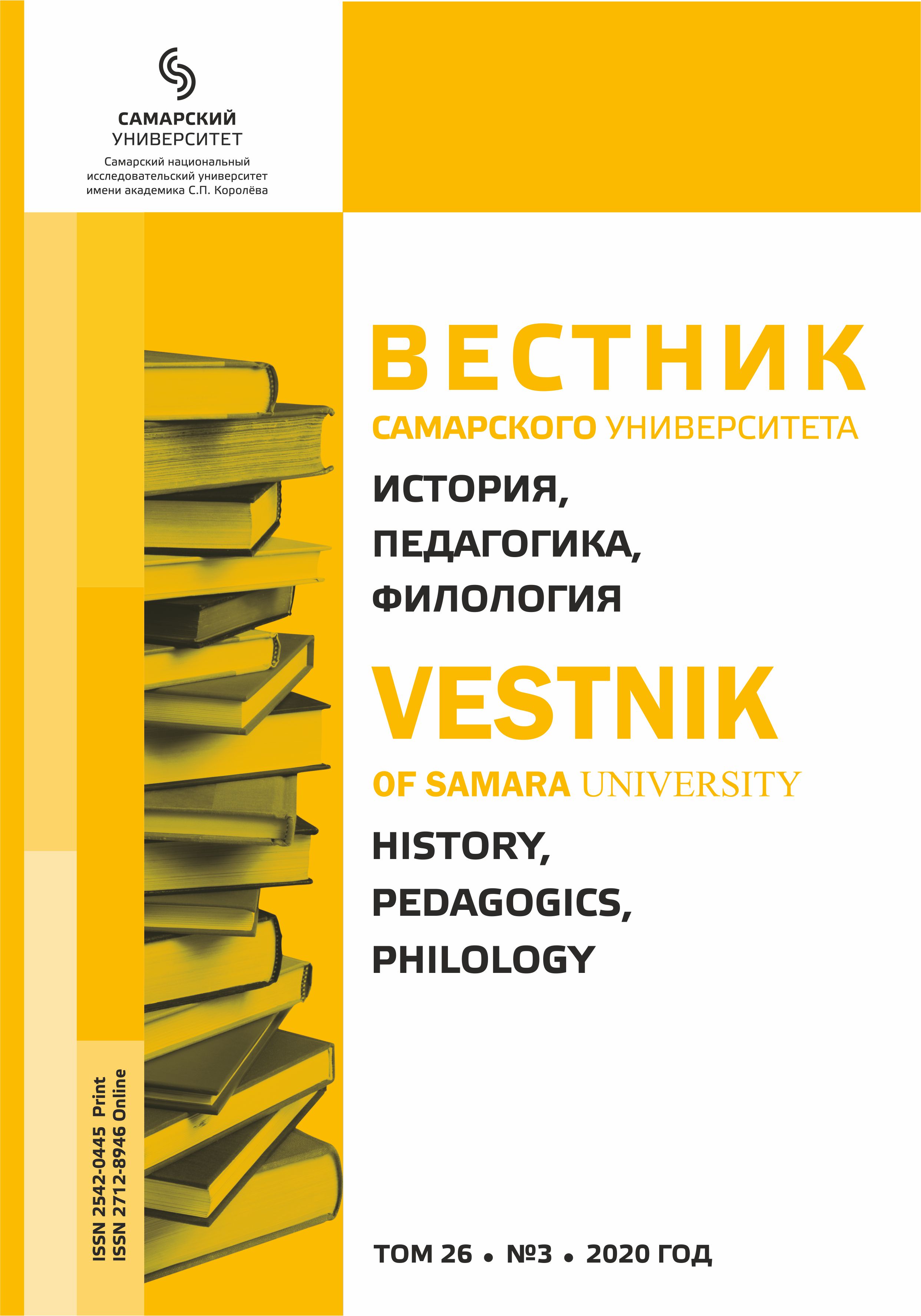Персонализированная профессиональная ориентация школьника: конструирование самореализации в деятельности
- Авторы: Мельник Н.М.1, Нестеренко В.М.1
-
Учреждения:
- Самарский государственный технический университет, г. Самара, Российская Федерация
- Выпуск: Том 26, № 3 (2020)
- Страницы: 43-50
- Раздел: Статьи
- URL: https://journals.ssau.ru/hpp/article/view/8183
- DOI: https://doi.org/10.18287/2542-0445-2020-26-3-43-50
- ID: 8183
Цитировать
Полный текст
Аннотация
В статье авторы рассматривают методология принципиально новой организации подготовки школьников к осознанной ориентации в быстро меняющейся профессиональной среде, суть которой – формирование способности школьника осмысленно конструировать инварианты своей профессиональной деятельности, обеспечивающие актуальное изменение состояния объекта в процессе выдвижения и реализации собственных идей. Доказывают целесообразность введения в учебный план дисциплины «Мир деятельности», содержание которой направлено на формирование целостной параметрической модели профессиональной деятельности субъекта и осмысленную реализацию аксиоматической взаимосвязи изменений в структуре направленности деятельности с изменениями состояния параметров объекта в условиях реальной среды. Описывают механизм развития способности школьника осуществлять трансформацию и конструирование видов деятельности в процессе актуализации взаимосвязи направлений активности: производственное, экологическое, научное, художественное, управленческое, педагогическое, медицинское, физкультурное, потребность, цель, самоопределение, нормы, критерии, содержание, методы, способности, способы деятельности. Утверждают, что осознанное управление выбором актуальных взаимосвязей направлений активности и их контекстным наполнением информацией, отражающей реальное состояние и изменения среды деятельности, позволяет школьнику вырабатывать оригинальные идеи и создавать множество вариантов их реализации, открывать для себя широкий спектр профессиональных траекторий и возможности самореализации в деятельности. Выявляют показатели продуктивности персонализированной профессиональной ориентации школьников: повышение производительности интеллектуальной деятельности, повышение персональной мотивации и потребности в прогнозировании перспективных сфер и видов деятельности, снижение непродуктивной загрузки памяти знаниями об известных сферах деятельности и профессиях, конструирование профессиональной деятельности в выбранной сфере в реальном времени.
Об авторах
Н. М. Мельник
Самарский государственный технический университет, г. Самара, Российская Федерация
Автор, ответственный за переписку.
Email: morenov@ssau.ru
ORCID iD: 0000-0003-2422-954X
кандидат педагогических наук, доцент, доцент кафедры «Психология и педагогика», Самарский государственный технический университет
В. М. Нестеренко
Самарский государственный технический университет, г. Самара, Российская Федерация
Email: morenov@ssau.ru
ORCID iD: 0000-0003-1381-6992
доктор педагогических наук, профессор, профессор кафедры «Психология и педагогика», Самарский государственный технический университет
Список литературы
- Guan, Zhuang, Cai, Ding 2017 – Guan, Y., Zhuang, M., Cai, Z., Ding, Y., Wang, Y., Huang, Z., et al. Modeling Dynamics in Career Construction: Reciprocal Relationship between Future Work Self and Career Exploration // Journal of Vocational Behavior, 2017, no. 101, pp. 21–31. doi: 10.1016/j.jvb.2017.04.003.
- Kononiuk, Pająk, Gudanowska, Magruk 2020 – Kononiuk A., Pająk A., Gudanowska A.E., Magruk A., Rollnik-Sadowska E., Kozłowska J., Sacio-Szymańska A. Foresight for Career Development // Foresight and STI Governance, 2020, vol. 14, no. 2, pp. 88–104. doi: 10.17323/2500-2597.
- Nesterenko 2018 – Nesterenko V.M. Conceptual principles of engineering education based on the approach to evolutionary activity // Handbook on research in the field of engineering education in a global context, 2018, pp. 463–476, IGI Global, Hershey, Pennsylvania, USA. doi: 10.4018/978-1-5225-3395-5.CH039.
- Rudolph, Lavigne, Zacher 2017 – Rudolph C.W., Lavigne K.N., Zacher H. Career adaptability: A metaanalysis of relationships with measures of adaptivity, adapting responses, and adaptation results // Journal of Vocational Behavior, 2017, no. 98, 17–34. DOI: 10.1016/j. jvb.2016.09.002.
- Аверьянова 2013 – Аверьянова С.Ю. Ключевые компетенции как факторы и результаты профессионального самоопределения старшеклассников // Научный диалог. 2013. № 8 (20). С. 120–130. URL: https://cyberleninka.ru/article/n/klyuchevye-kompetentsii-kak-faktory-i-rezultaty-professionalnogo-samoopredeleniya-starsheklassnikov.
- Блинов, Сергеев 2015 – Блинов В.И., Сергеев И.С. Профессиональные пробы в школьной профориентации: путь поисков // Профессиональное образование и рынок труда. 2015. № 4. С. 14–17. URL: https://www.elibrary.ru/item.asp?id=23803952.
- Гришина – Гришина И. Карьера как предчувствие: зачем нужна новая система профориентации. URL: https://trends.rbc.ru/trends/-education/5dbaa6cc9a79474002964e21.
- Зборовский, Амбарова 2019 – Зборовский Г.Е., Амбарова П.А. От образовательной неуспешности – к социальной успешности // Высшее образование в России. 2019. Т. 28, № 11. С. 34–46. doi: 10.31992/0869-3617-2019-28-11-34-46.
- Кудряшова, Сорокин, Бугаенко 2020 – Кудряшова Е.В., Сорокин С.Э., Бугаенко О.Д. Взаимодействие университетов со сферой производства как элемент реализации «третьей миссии» // Высшее образование в России. 2020. Т. 29, № 5. С. 9–21. doi: 10.31992/0869-3617-2020-29-5-9-21.
- Лалетина, Липатов 2018 – Лалетина О.В., Липатов Д.В. Роль дополнительного образования в профессиональной ориентации школьников // Отечественная и зарубежная педагогика. 2018. Т. 2, № 2(49). С. 192–199. URL: https://elibrary.ru/item.asp?id=35594446.
- Мельник, Нестеренко 2019 – Мельник Н.М., Нестеренко В.М. Высокотехнологичная педагогика созидания: аксиологический и эволюционно-деятельностный подходы // Научный результат. Педагогика и психология образования. 2019. Т. 5, № 4. С. 3–13. doi: 10.18413/2313-8971-2019-5-4-0-1.
- Мельник 2018 – Мельник Н.М. Деятельностная дидактическая платформа развития опорного университета // Научный результат. Педагогика и психология образования. 2018. Т. 4, № 4. С. 20–31. doi: 10.18413/2313-8971-2018-4-4-0-2.
- Мельник 2017 – Мельник Н.М. Эволюционно-деятельностное образование – основа системной консолидации инновационной деятельности университета, предприятий, бизнеса // Научное мнение. 2017. № 12. С. 62–67. URL: https://www.elibrary.ru/item.asp?id=30780686.
- Рябоконь 2016 – Рябоконь М.В. Модели поведения абитуриентов при выборе вуза // Вестник Нижегородского университета им. Н.И. Лобачевского. Серия: Социальные науки. 2016. № 4 (44). С. 177–185. URL: https://cyberleninka.ru/article/n/modeli-povedeniya-abiturientov-pri-vybore-vuza.
- Сергеев 2019 – Сергеев И.С. Региональные модели профориентации: актуализация настоящего или подготовка к будущему? (по результатам мониторинга ФИРО РАНХИГС) // Профессиональное образование. Столица. 2019. № 11. C. 10–18. URL: https://www.elibrary.ru/item.asp?id=41424730.
- Субиркина 2019 – Субиркина Н.Ю. Кластерный подход в организации системы профориентации // Развитие образования. 2019. № 1 (3). С. 50–53. doi: 10.31483/r-22133.
- Смык, Прусова, Зиманов, Солнцев 2019 – Смык А.Ф., Прусова В.И., Зиманов Л.Л., Солнцев А.А. Анализ масштаба и причин отсева студентов в техническом университете // Высшее образование в России. 2019. Т. 28, № 6. С. 52–62. doi: 10.31992/0869-3617-2019-28-6-52-62.
- Толстогузов 2014 – Толстогузов С.Н. Современные подходы к организации профориентационной работы классического университета в системе профессионального самоопределения старшеклассников // Вестник Тюменского государственного университета. Социология. 2014. № 8. C. 40–49. URL: http://www.elibrary.ru/item.asp?id=22624948.
Дополнительные файлы













